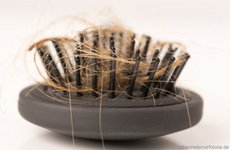Hair loss: When the jungle gets thinner

Every third man and every tenth woman suffers from hair loss. "In order to recognize true hair loss, one should simply look at four factors over a prolonged period of time," advises Professor Dr. Maja Mockenhaupt. She is Managing Senior Physician in the Department of Dermatology at the Medical Center – University of Freiburg.
These factors are:
- Are the hairs simply broken off? Can you still discern the roots? Medically speaking, hair loss means losing more than two hundred hairs, with the roots, daily.
- Is your hair dyed? Do you sport a permanent wave, or often blow-dry your hair hot? Beautifications like these attack the hair and increase the risk of hair loss.
- What is your general state of well-being? Hormonal changes such as puberty, pregnancy or menopause can temporarily increase hair loss. Other causes can be stress, depression or even thyroid dysfunction.
- Do you need to take medication? Have you often eaten unhealthily recently? An unbalanced diet or iron deficiency can result in hair loss.
In some cases, the body simply needs a bit of time to recover. In case of a disease or deficiency, one should act against this. If all these factors have been ruled out, the person affected should consult a doctor. "There are different types of hair loss. It can be limited to various areas of the head, or to the whole head, or in rare cases can even affect the whole body," explains Professor Mockenhaupt.
The following types of hair loss can be distinguished:
Pattern hair loss
This congenital hair loss is the most common type in both women at 80 percent and men at 95 percent. It usually appears after the age of 30, in women often during menopause. "Overproduction of the hormone testosterone is not, as often claimed, the cause, but rather a hereditary susceptibility of the hair roots to this hormone," says Professor Mockenhaupt.
Spot baldness (alopecia areata)
The cause of this type of hair loss has not yet been fully explained. Clearly delineated bald spots of various sizes appear on the head or over the whole body. This is thought to be triggered by immune cells that are wrongly directed against one's own body. Certain cells in the hair roots are perceived as intruders and repelled by the immune system. An inflammatory reaction is usually associated with this. As suddenly as the hair falls out, the inflammation can also subside again, and the hair can regrow.
Diffuse hair loss
This type usually affects the whole head. The hairs become ever thinner over time and eventually fall out. The cause is often an under-supply of important nutrients, which can be triggered by illness, medication, bad diet or stress in the sense of an extraordinary burden.
Potential remedies: "Hands off miracle drugs that supposedly help against everything," warns Professor Mockenhaupt. Important is that the cause of the hair loss be clarified. The earlier the correct diagnosis is made, the better the patient and doctor can counteract it, especially if a disease or hormone disorder is behind it. There are in some cases effective preparations to take, but these vary considerably depending on the type of hair loss. A comprehensive medical consultation can help to clarify all the possibilities.
Back